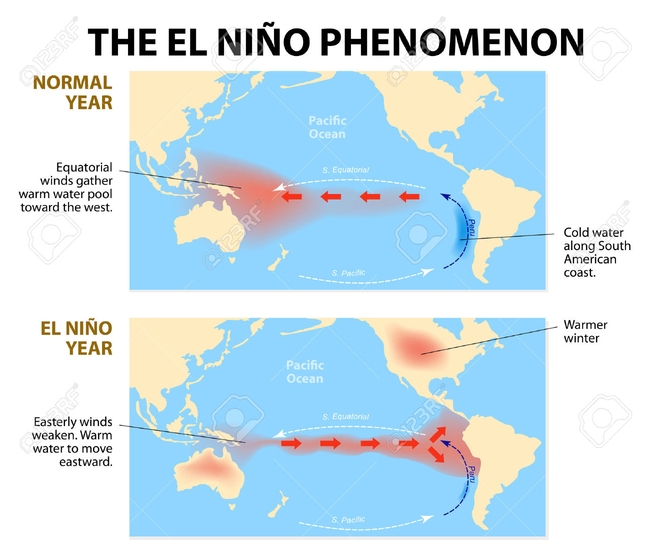
In a recent forecast, the National Weather Service said Northern California stands a decent chance of getting significant rain from this winter's El Niño weather pattern. The bulk of the precipitation will fall in December, January and February. If you haven't already done so, it's time to start preparing for El Niño. Here are 10 steps to take:
Clean up your yard.Inspect your landscape for debris, outdoor furniture or other objects that could be tossed by storm winds. Spend an afternoon tidying up the yard and storing or securing furniture and other loose items to prevent a frantic scramble to collect items that have landed on your roof or in your neighbor's yards.
Inspect gutters and downspouts. Make sure gutters are clear of leaves and other debris and connections between gutters and downspouts are functioning properly. Faulty gutters and downspouts can also lead to soil erosion adjacent to buildings and serious water and foundation displacement problems in basements and crawl spaces. Make sure downspouts direct water away from buildings and do not create standing water. Storm water runoff from impermeable surfaces (roofs, driveways, patios) should be directed into a collection system to avoid soil saturation.
Inspect your roof. Roofs with loose tiles or holes spell trouble. Inspect flashing to ensure water is directed away from seams and joints.
Inspect retaining walls. Check retaining wall drains, surface drains, culverts and ditches for obstructions or other signs of malfunction. Do this review before the storm season and after every storm.
Inspect slopes. Monitor sloped areas for signs of gullying, surface cracks and slumping. Inspect patios, retaining walls and garden walls for signs of cracking or rotation, which might indicate slope movement. If you notice problems, have the site inspected by a geotechnical engineer.
Vanquish bare ground. Make sure your yard and garden does not have bare areas that could initiate mudflows during a storm. Fall is a good time to put down mulch and establish native plants. There may still be time to encourage vegetation in bare areas before the storm season.
Review storm drains.Inspect storm drains before the storm season and after every rain. If drains are obstructed, clear the material from the drain or notify the Department of Public Works or the public agency responsible for drain maintenance.
Monitor trees.If any trees appear weakened by drought, ask an arborist to inspect them. High winds can fell trees, and their branches can knock out power or seriously damage homes and vehicles.
Install swales and French drains. If you have areas that flood, consider installing swales or French drains to move the water to where it can better infiltrate the soil. Swales slow and capture runoff by spreading it horizontally across the landscape. Create a swale by digging a ditch on contour and piling the dirt on the downhill side of the ditch to create a berm.
A French drain is a trench filled with gravel or rock containing a perforated pipe that redirects surface water and groundwater away from an area. A French drain can have perforated hollow pipes along the bottom to quickly vent water that seeps down through the upper gravel or rock. French drains are primarily used to prevent ground and surface water from penetrating or damaging building foundations.
Consider further steps. If you still have concerns about slope stability, flooding and mudflows after taking these steps, consider stockpiling sandbags and plastic sheeting, straw wattles or straw bales. These items can form a barrier to keep water from flooding low areas. Plastic sheeting can be placed on slopes and secured with sandbags to prevent water from eroding the soil.
Workshop: U. C. Master Gardeners of Napa County will host a workshop on El Niño on Saturday, October 31, from 9:30 a.m. to 11:30 a.m., at the University of California Cooperative Extension Office (address below). An El Niño winter is on the horizon, no doubt about it. Napa County could well see heavier than average rainfall. This workshop will focus on measures to take now to prepare your home and garden for heavy rain. You will also learn steps to take during and after a flood. Online registration (credit card only) Mail-in registration (cash or check only).
Master Gardeners are volunteers who help the University of California reach the gardening public with home gardening information. U. C. Master Gardeners of Napa County ( http://ucanr.org/ucmgnapa/) are available to answer gardening questions in person or by phone, Monday, Wednesday and Friday, 9 a.m. to Noon, at the U. C. Cooperative Extension office, 1710 Soscol Avenue, Suite 4, Napa, 707-253-4143, or from outside City of Napa toll-free at 877-279-3065. Or e-mail your garden questions by following the guidelines on our web site. Click on Napa, then on Have Garden Questions? Find us on Facebook under UC Master Gardeners of Napa County.